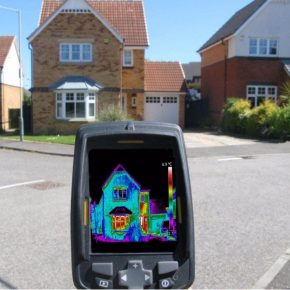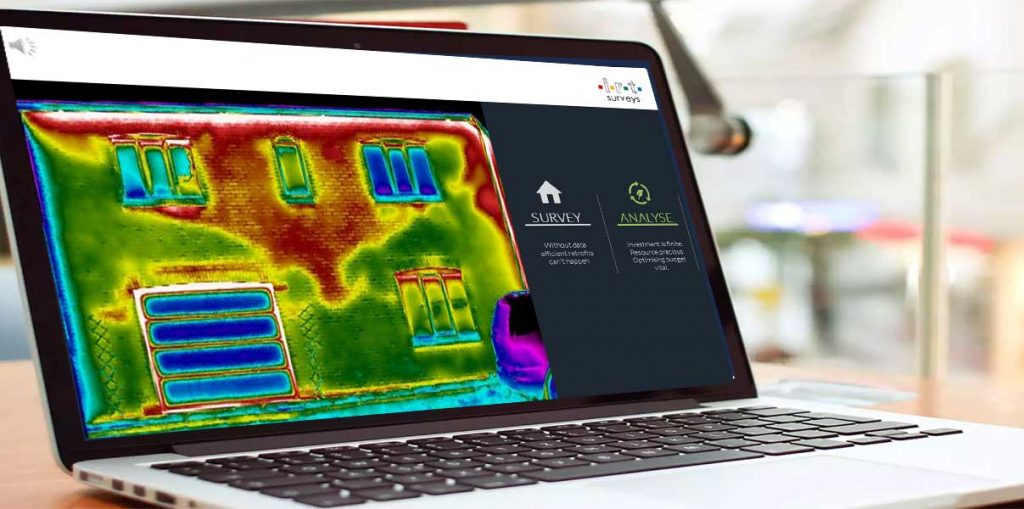
GUEST ARTICLE: Why thermal imaging is best practice in energy-efficient retrofits
 Despite decreases in energy costs over the last twelve months and the government easing back on some net-zero targets, the impact of carbon emissions and high energy prices is still keenly felt across the UK. For architects, specifiers, contractors, building surveyors and property developers, the challenge of retrofitting the country’s housing stock to improve energy efficiency and reduce emissions remains a key priority. Stewart Little, CEO of IRT Surveys, part of the Mears Group, explains how carrying out thermal imaging is best practice when surveying housing stock and how it enables stakeholders to make smarter retrofit decisions…
Despite decreases in energy costs over the last twelve months and the government easing back on some net-zero targets, the impact of carbon emissions and high energy prices is still keenly felt across the UK. For architects, specifiers, contractors, building surveyors and property developers, the challenge of retrofitting the country’s housing stock to improve energy efficiency and reduce emissions remains a key priority. Stewart Little, CEO of IRT Surveys, part of the Mears Group, explains how carrying out thermal imaging is best practice when surveying housing stock and how it enables stakeholders to make smarter retrofit decisions…
According to the Energy and Climate Intelligence Unit, between Oct 2023 and October 2024, homes with an EPC rating of F will pay £721 more for their energy than a home rated C. Amidst a biting cost of living crisis, this will have a significant financial impact on families while contributing substantially to CO2 emissions. Indeed, forecasters predict that by 2050, 95% of built environment emissions will come from the UK’s housing stock. While the need to retrofit is therefore urgent, it is vital that retrofit strategies aim to make homes as energy-efficient and low-carbon as possible.

A more effective way to survey properties
While the construction industry knows what solutions are available to improve energy efficiency – new insulation, triple glazing, eradicating leakages, installing sustainable heating and electricity, for example, best practice dictates that before commencing retrofit work, individual homes need to be effectively surveyed to identify their particular energy-wasting issues. This way, not only is the work tailored to the requirements of individual properties, but expensive measures are not implemented where they are not needed, cutting the costs of the retrofitting project.
To identify energy efficiency and emissions issues, and calculate the cost of addressing them, architects, specifiers, surveyors, developers and contractors rely on Building Information Modelling (BIM) for building envelope thermal performance analysis and energy efficiency evaluation. As part of best practice, however, thermal imaging should be a key element of the survey process.
As a non-invasive method of surveying a property, thermal imaging negates the need to pay for costly repairs, and more importantly, it clearly identifies energy inefficiencies in a building’s structure. Furthermore, it enables stakeholders to see exactly where heat is escaping from a building. It can detect problem areas such as poorly insulated walls, gaps in window fittings, waterproofing and rendering issues, and hidden flaws in construction – problems that are not always detected by other forms of survey. As a result, the level of detail thermal imaging provides can be invaluable when developing an effective retrofit strategy, enabling construction specialists to target the specific issues of individual properties rather than adopting a potentially wasteful one-size-fits-all approach.
In the context of today’s high inflation, interest rates and energy costs, there are obvious advantages to deploying such precise surveying techniques as part of a retrofit programme. For occupants, there are not only financial savings from reduced energy bills, but also the increased comfort of living in a warmer home and the reassurance it will cost less to heat. For the property’s owners and residents, there’s also the knowledge that the living space is contributing less to climate change.
Data-driven retrofit strategies
The path to implementing an effective retrofit strategy is not without its challenges. Two particular hurdles are selecting the right approach for a particular project and accessing available funding. Here, too, partnering with an established and experienced thermal imaging provider can be beneficial, their expertise providing essential guidance on the most effective retrofitting strategies and how to access available grants and funding.
Using the latest cloud-based software, thermal imaging specialists can combine BIM, thermal imaging and other data to assess a housing portfolio’s energy performance and identify the most effective ways a retrofit can save energy. It can even provide instant information about available grants.
Indeed, integrating infrared thermal imaging with energy-saving calculator technology offers a previously unattainable level of accuracy for retrofit projects. This impartial, data-driven, ecosystem approach provides industry professionals with assured outcomes for their retrofit projects, ensuring they are not only effective but also cost-efficient.
For construction professionals tasked with retrofitting the UK housing stock, the value of thermal imaging, paired with energy-saving calculator technology, has never been higher. Embedding it into best practice ensures that retrofitting strategies are effective and have assured outcomes. As a result, it helps reduce carbon emissions, brings financial savings and improves residents’ standards of living by making homes warmer, less expensive to run, and freer from damp or mould.
Latest news

26th July 2024
Enfield Speciality Doors completes world-class project for Atlas Copco HQ
A rundown office and warehouse building completely transformed into a modern headquarters for Atlas Copco has been fitted with more than 120 internal fire doors from Enfield Speciality Doors.
Posted in Access Control & Door Entry Systems, Articles, Building Industry News, Building Products & Structures, Building Systems, Case Studies, Doors, Interior Design & Construction, Interiors, Posts, Restoration & Refurbishment, Retrofit & Renovation, Security and Fire Protection, Sustainability & Energy Efficiency, Timber Buildings and Timber Products, Wooden products
26th July 2024
Abloy UK launches new white paper
Abloy UK, a leading provider of security and access control solutions, has launched a new white paper.
Posted in Access Control & Door Entry Systems, Architectural Ironmongery, Articles, Building Industry News, Building Products & Structures, Building Services, Doors, Facility Management & Building Services, Health & Safety, Information Technology, Innovations & New Products, Publications, Research & Materials Testing, Security and Fire Protection
26th July 2024
MCRMA Member Profile: David Roy, Director of Roofconsult
David Roy of MCRMA member company Roofconsult has more than 50 years’ experience to draw upon working in the building envelope sector and a unique perspective on how it has changed in that time.
Posted in Articles, BIM, Infrastructure & CAD Software, Building Associations & Institutes, Building Industry News, Building Products & Structures, Building Services, Building Systems, Cladding, Information Technology, Restoration & Refurbishment, Retrofit & Renovation, Roofs, Walls
26th July 2024
Strand: Enhancing Door Functionality and Safety
Craig Fox, Sales Director for Strand Hardware, outlines how door industry professionals might apply door limiting stays…
Posted in Architectural Ironmongery, Articles, Building Industry News, Building Products & Structures, Building Services, Doors, Facility Management & Building Services, Health & Safety, Restoration & Refurbishment, Retrofit & Renovation
 Sign up:
Sign up: